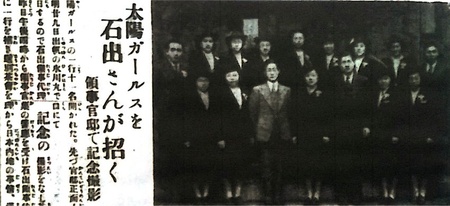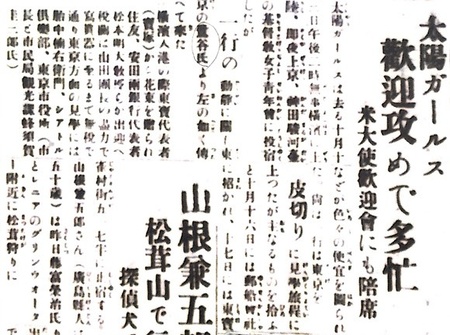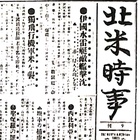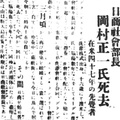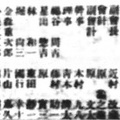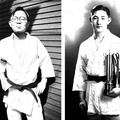In the last chapter, I wrote about the activities of the Kibei Japanese American Citizens League. This chapter will report on the Nisei Girls’ Japan Delegation Tours.
These Nisei girls who were born in the United States learned the Japanese language, culture, and customs at Japanese schools and from their parents, but they did not understand Japan very well. To help them experience what Japan was actually like, multiple tour groups were formed around 1939 and 1940. These groups stayed in Japan for an extensive period of time, visiting numerous places around the country. I would like to introduce some interesting articles1 that reported on the first impressions of these Nisei American Girls.
The Rise of Japan Delegation Groups
At the Pacific Coast Consul Conference, represented by the Consulate-General of Japan in San Francisco and consulates in Los Angeles, Portland, and Seattle, the participants discussed how to facilitate the Nisei groups’ tours to Japan, which were organized quite frequently at the time, and they proposed some detailed guidelines.
“Agreement at Consul Conference” (November 1, 1939 issue)
As there have been several cases of double-booking arrangements or mistakes that complicated the tours, the participants at the coastal consul conference held in San Francisco the other day have set the following guidelines for those groups preparing trips to Japan.
*Notes on the preparation of the Nisei Delegation tour before their departure to Japan (proposed at the consul conference)
1. All arrangements must be sponsored or co-sponsored bythe Nihonjin-kai (Japanese Committee) or their related groups.
2. The Ministry of Foreign Affairs of Japan is the one in charge of arrangements.
3. The Ministry of Foreign Affairs of Japan should contact related parties in Tokyo (such as newspapers and magazines) as well as those in other related fields at the destinations.
4. Consulates should notify the Ministry (of Foreign Affairs of Japan) at least a month before the departure.
In response to these guidelines by the consulates, the president of The North American Times, Sumikiyo Arima, commented in his column “Hokubei Shunjyu” as follows.
“Japan Delegation and the Ministry of Foreign Affairs” by Ichiro Hanazono (November 3, 1939 issue)
Due to the recurring instances of double booking and other mistakes, the delegation often couldn’t fulfill the purpose of their visit to Japan so that the recent consul conference addressed that issue. While I believe their intention should be appreciated because it is derived from a kind consideration for the fellow Japanese, their guidelines do not suit the reality of the situation…
I have to question the parts where they require the Nihonjin-kai’s involvement or the Ministry of Foreign Affairs to be in charge of arrangements. That all sound too systematic. The Taiyo (sun) Girls Delegation, who are currently visiting Japan, must owe their adequate planning to the passion and sincerity of Mr. Okada, not the Nikkai (Nihonjin-kai). If the consulates were to say they would not make arrangements unless things were hosted by Nikkai, wouldn’t they end up obsessing over formalities and overlooking the reality?”
Touring Japan by Taiyo Girls Delegation
The Taiyo Girls are described in the 1940 edition of Zaibei nihonjin shi (History of the Japanese in the U.S.) as follows:
As per Banzo Okada’s proposal, young females involved in the Taiyo Baseball Club were gathered in 1925 with an aim to facilitate social interaction and discipline, and they are known for sending delegation to Japan every once in a while. Currently, their 5th delegation is visiting Japan.
There were several articles reporting about the 5th delegation of Taiyo Girls who left Seattle on September 29, 1939.
The Farewell Party in Seattle on September 27, 1939
“Mr. Ishide Invites Taiyo Girls” (September 28, 1939 issue)
As the eleven members of Taiyo Girls are leaving for Japan by the Hikawa-maru which will depart tomorrow on the 29th, Acting Consul Ishide invited them to the official residence of consuls and held a farewell tea party.
Arriving in Yokohama and Touring Tokyo around October 13 - 20, 1939
“Taiyo Girls on the Radio” (October 18 and 19, 1939 issues)
Having arrived in Yokohama on the 13th, the Taiyo Girls have been traveling to Yokosuka and various areas in Tokyo, and on the 18th at 9:30 pm, they talked about their impressions of Japan on Japan Broadcasting Corporation’s (NHK) shortwave broadcast. The connection was quite bad, but their message can be more or less summarized as follows:
“We’re all in good shape and continuing on our observation tour. We’ve met the mayor of Tokyo, paid a visit to Yasukuni Shrine and received an invitation from Major General Hirabayashi (one of our members, Gloria Hirabayashi’s uncle). We are currently staying at a girls’ youth center.”
“Taiyo Girls Welcomed Non-Stop on Hectic Schedule” (October 30, 1939 issue)
Seiichi Uguisudani in Tokyo informed us about the activities of the Taiyo Girls:
“Starting their journey in Tokyo, they were invited by Yusen Company (a steamship company) on October 16 and on the 17th they saw a show at Toho (Takarazuka). They also attended tea parties at the Seattle Club and the Ministry of Education. On the 19th, they had the honor of attending a welcome party for United States Ambassador to Japan Grew, which was hosted by The America-Japan Society. They also visited the mayor of Tokyo and the Ministry of the Army and the Navy and watched a baseball game between Waseda University and Keio University.”
A detailed account of their tour in Tokyo around October 16 to 20 was reported by Akira Maeda, who accompanied the trip. It was published across two issues. Below are some excerpts from the articles which I found notable.
“Tokyo Tour of Taiyo Girls, Part 1 & 2” by Manager Akira Maeda (November 13 and 14, 1939 issues)
On the 16th, when the Taiyo Delegation was invited to the Prime Minister’s office for a tea party, they sang the song of Taiyo delegation and Aikoku Koushinkyoku (Patriotic March).
On the 17th, the delegation was received by Royal Highnesses Prince and Princess Takamatsu and was asked a question about their thoughts on their visit to Japan.
The Shufu-no-tomo company welcomed the Taiyo Girls, introduced them to Ms. Waka Yamada and its employees, and treated them to a meal.
On the 18th, the delegation visited the Tokyo Teachers’ Schools for Girls and had a chance to talk with some distinguished individuals in Japan, who were arranged by the Association for International Cultural Promotion.
On the 19th, the delegation visited the Ministry of Education and met Administrative Vice-minister Ryutaro Sakuta. At the welcome party, hosted by United States Ambassador Grew, they had the opportunity to speak with some influential individuals such as Yukio Ozaki, Saburo Yatabe, and Kikusaburo Fukui. The delegation had dinner with Sumikiyo Arima, the former president of The North American Times and father of Sumiyoshi Arima the current president. His wife also joined them.
On the 20th, the delegation had the honor of seeing His Majesty the Emperor’s visit to Yasukuni Shrine at the Special Festival. This was their last day of the Tokyo tour.2
In the article titled “From Tokyo,” which was published in the November 15, 1939 issue with his pen name of Ogakusei, Sumikiyo Arima, the former president of The North American Times, who happened to be in Tokyo at the time, commented on the Taiyo Girls Delegation.
The Taiyo Girls Delegation came to Japan at a good timing, understood the loyalty of Japanese people, and learned how Japanese culture had advanced in many aspects. The Seattle Club held an evening banquet on October 18 at Maruni Diner, which is run by Mr. Ota. They invited the group, Shigeji Kasai, who is going to be appointed Colonial Advisor and the former Vice-minister of Foreign Affairs, and Tomesaburo Shimizu. The banquet was quite a success with a large attendance. . .
Mr. Shimizu studied at the University of Washington in 1903 and has moved to the east to further pursue his studies. The Taiyo Delegation was led by Yutaka Ueda, a former California resident and a large contributor to Nisei education, Toshi Morishita, and Akira Maeda. With additional assistance from Seiichi Uguisudani and Takizo Matsumoto, the delegation visited various locations like schools and attended multiple welcome parties. . .
As I happened to be in Tokyo, I, as a representative of The North American Times, invited the delegation to a get-together at the Maruni Diner and enjoyed having casual conversation. The members were happy to have an opportunity to relax and enjoy themselves at that night.
Touring From Kamakura to Nikko around October 21 to 23, 1939
“Touring Nikko by Taiyo Delegation” by Akira Maeda (December 15, 1939 issue)
The delegation will visit a military port of Yokosuka, Kamakura, Enoshima, Tamagawa Gakuen, and then head to Nikko. They will see Kegon Falls, visit Chugushi Shrine and Toshogu Yomeimon Gate, and then leave for Sendai from Nikko.
Touring in Matsushima around October 25 – 26, 1939
“Touring in Tohoku by Taiyo Delegation” by Akira Maeda (December 18, 1939 issue)
The delegation went to see the island of Matsushima and ‘Tsukimitei,’ a place that both Toyotomi Hideyoshi and Emperor Taisho had visited. They arrived at Shinohara in the rain. When they arrived in Nagano, it was dark because an air defense exercise was taking place.
Touring in Nagano around October 27 – 28, 1939
“The Taiyo Delegation heads to the snow-covered Nagano” by Akira Maeda (December 19, 1939 issue)
The delegation attended a Buddhist sutra at the Zenkoji temple and visited the Itakura Silk Mill, where there are approximately 1,000 female and 2,000 male workers. For lunch, the factory director treated them to a Western meal, which they all thoroughly enjoyed because they had not had that kind of meal in a while.
The owner of the Western restaurant, Mr. Morishita, used to live in Seattle and regularly bought sweets at Kaiundo on Main Street. That very person is now making sweets with the same name and succeeding in business with a lot of employees.
Touring in Osaka around November 4 - 5, 1939
“Taiyo Girls Welcomed by Daimai-sha” (November 29, 1939 issue)
Sixteen Nisei girls from Seattle traveled to Japan for preparation for their marriage and finding future husbands. They are all 18 to 19 years of age, the bloom of their youth. On the first day in Osaka, they were invited to the tea ceremony at the Takarazuka hotel being the main event, which was hosted by the international department at Daimai-sha. Despite the rainy weather, they fully and peacefully immersed themselves in various Japanese culture. It became a very memorable day for them.
Notes:
1. All article excerpts are from The North American Times unless noted otherwise.
2. The Taiyo Girls left Tokyo on October 22. Their next destination was Nikko.
*The English version of this series is a collaboration between Discover Nikkei and The North American Post, Seattle’s bilingual community newspaper. This article was originally publishd in Japanese on August 30, 2022 in The North American Post.
© 2023 Ikuo Shinmasu



